|
|
JAMES BOND FACT FILES |
|
|
JAMES BOND FACT FILES |
|
||||
 |
||||
|
||||
|
The Signet paperback of YOU ONLY LIVE TWICE was widely reported in the US press as having the largest print-run in publishing history, with a staggering 2,700,007 copies produced for July 22, 1965, followed by a further 300,000 a few days later. Signet also re-issued a box set on July 22, 1965 which contained 11 James Bond novels up to and including ON HER MAJESTY'S SECRET SERVICE. Now erroneously titled The Complete Ian Fleming, the box set had previously been available as The Amazing James Bond in 1963 (10 books not including OHMSS); and later to include YOU ONLY LIVE TWICE at the end of 1965 and THE MAN WITH THE GOLDEN GUN in 1966, both times issued under the title The Complete James Bond. |
||||
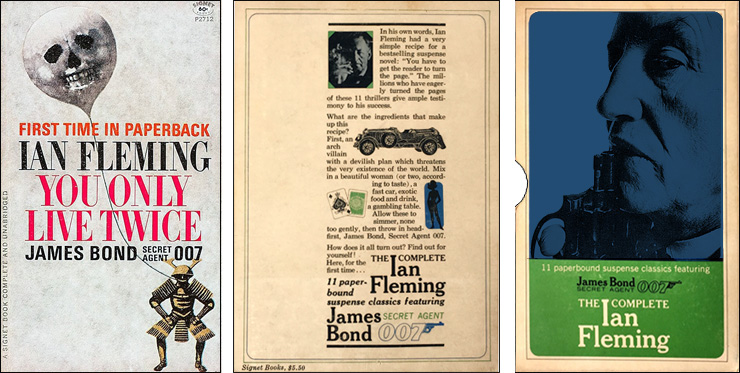 |
||||
|
In order to capitalise on the success of Goldfinger and sustain interest before the release of Thunderball in December 1965, United Artists re-released Dr. No and From Russia With Love on a double-bill from May 26, 1965. Originally playing at 26 cinemas in New York, the double-bill generated more revenue for the two films than that of their original US release. The opening day gross in New York alone beat that of Goldfinger, and the double-bill went on to similar success when it had a wider release across America. The interest in all things James Bond was reaching a high point on both sides of the Atlantic. Sales of Signet's paperbacks rocketed as a result with CASINO ROYALE having now sold 2.5-million copies; DOCTOR NO 2.7-million, FROM RUSSIA, WITH LOVE 2.9-million, and GOLDFINGER 3.1-million copies - no doubt boosted by the popularity of the latest film. |
||||
|
Also published for the first time in the USA in April 1965 was 007 James Bond: A Report by Oswald Frederick Snelling. The author (known to his friends as O. F.) was an acquaintance of Ian Fleming, and his book was the first serious examination of the world of James Bond, and had been published to great success in London (under the title Double-O-Seven James Bond: A Report) by The Holland Press in 1964. The US rights were acquired by Ian Fleming's publisher the New American Library, who were now wanting more James Bond product to satisfy the public's insatiable appetite. The Signet paperback was generally well-received although the Chicago Tribune of April 11, 1965 bizarrely offered up two different viewpoints from the same reviewer; one good, one bad. The review by Clarence Petersen titled ‘The Ambidextrous Critic’ was accompanied by two caricature line drawings [pictured below] instantly recognisable as Sean Connery, who by now was firmly established as James Bond in the eyes of the public. O. F. Snelling (1916-2001) knew Ian Fleming via his work in Sotheby's rare book department, and assisted the author in research for several of his James Bond novels. 007 James Bond: A Report was therefore endorsed by Ian Fleming and the hardback edition was rush-released in the UK ahead of The James Bond Dossier by Kingsley Amis, which was being written at the same time. |
|||
|
The initial success of Snelling's book was due to the fact it was published around the time of Ian Fleming's death and the release of YOU ONLY LIVE TWICE. The Signet paperback featured the same typeface and style as their Ian Fleming novels. June 1965 then saw the US paperback publication of Thrilling Cities from Signet Books. The paperback edition also included the black & white vignette illustrations by celebrated graphic designer Milton Glaser at the start of each chapter, missing from the UK editions. Milton Glaser's Push Pin Studios had designed the dust jacket for the 1964 hardback edition which featured a battered suitcase, and although no designer is credited on the paperback, one can assume that it was the same studio as a similar, but slightly less-battered suitcase appears on the cover. |
||||
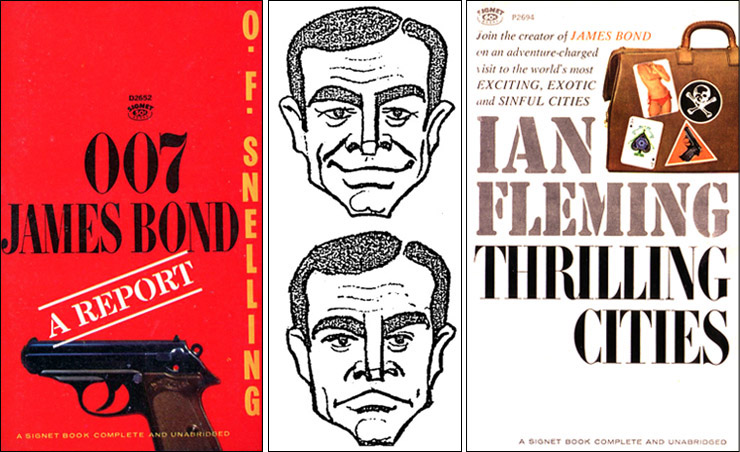 |
||||
|
On June 29, 1965 the New American Library then published their hardcover edition of The James Bond Dossier by Kingsley Amis, with a dust jacket designed by Paul Bacon. Amis's critique of the literary world of James Bond had been published in London by Jonathan Cape a month earlier, and was also a hit in the USA being reprinted twice more within a month of its release. The rear cover featured a photograph of Kingsley Amis taken at a Jonathan Cape event in London by renowned German-born photojournalist Frank Herrmann for The Sunday Times. Although not shown on the rear cover, Amis was chatting with Beatle John Lennon, whose two books of nonsensical stories, poems and drawings, In His Own Write (1964) and A Spaniard In The Works (1965), were also published by Jonathan Cape. Frank Herrmann had also taken photographs of the meeting between Sean Connery and James Bond author Ian Fleming on Ken Adam's reactor room set during the filming of Dr. No at Pinewood Studios on March 22, 1962. A well-respected novelist in his own right, Kingsley Amis (1922-1995) was considered something of an expert on Ian Fleming, with whom he had been corresponding whilst writing The James Bond Dossier, and Fleming had approved of the early manuscript before his death in August 1964. Amis was later consulted by Jonathan Cape prior to the publication of THE MAN WITH THE GOLDEN GUN, and made several suggestions for alterations to Ian Fleming's original manuscript which had not been fully revised at the time of his death, although these were ultimately not used. Kingsley Amis also wrote the more tongue-in-cheek volume The Book Of Bond (Or Every Man His Own 007), published in London by Jonathan Cape in 1965, and more famously the first (and arguably the best) original James Bond continuation novel COLONEL SUN in 1968. |
||||
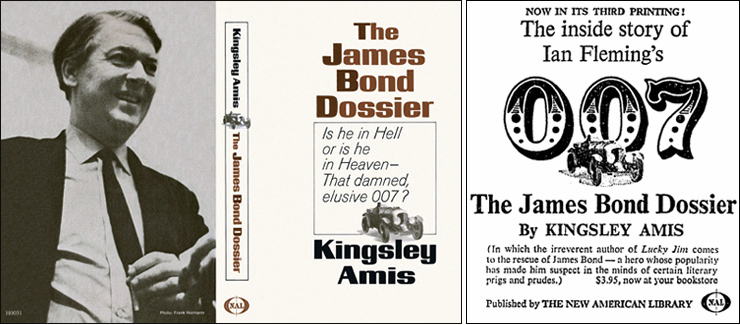 |
||||
|
||||
|
Mixed reviews did not prevent THE MAN WITH THE GOLDEN GUN from staying on the US bestseller list for fifteen weeks, peaking at number six. The New Yorker review compared Fleming's final James Bond novel with previous adventures: “There is little else here to recall those earlier days. There is no cheerful fornication, no breathless chemin-de-fer, no gourmet meals, no joyous drinking, no extraordinary physical exertions, and only the merest dribble of spilled blood”. Unsurprisingly, Anthony Boucher in the New York Times asserted that “...this posthumous story contains no imaginative criminal plot, no worthy Bond-antagonist, and not even a Bond-girl”. Back in the UK Kingsley Amis, normally a Bond supporter (who suggested revisions to Ian Fleming's final un-polished manuscript prior to publication) had also earlier blasted the novel in his review for The New Statesman, calling it “a sadly empty tale, empty of the interests and effects that for better or worse, Ian Fleming made his own”. |
||||
|
|
||||
|
Regardless of the reviews, THE MAN WITH THE GOLDEN GUN sold more copies in hardcover in the USA than any other James Bond title, although it was in paperback that the novels were selling in even greater numbers. Other publishers were keen to take advantage of the renewed interest in hardcover sales, and although the New American Library held the US paperback rights to all of Ian Fleming's works, Macmillan still held the hardcover rights to the first seven James Bond novels. Following the success of their first anthology Gilt-Edged Bonds in 1961, Macmillan hastily issued a follow-up entitled More Gilt-Edged Bonds in August 1965. This time the omnibus contained LIVE AND LET DIE, MOONRAKER and DIAMONDS ARE FOREVER. Only ever issued in hardcover, the collection had a dust jacket designed by Lawrence Ratzkin (1931-2011), although there appears to be little actually designed other than the placing of text, indicating a very rushed release. |
||||
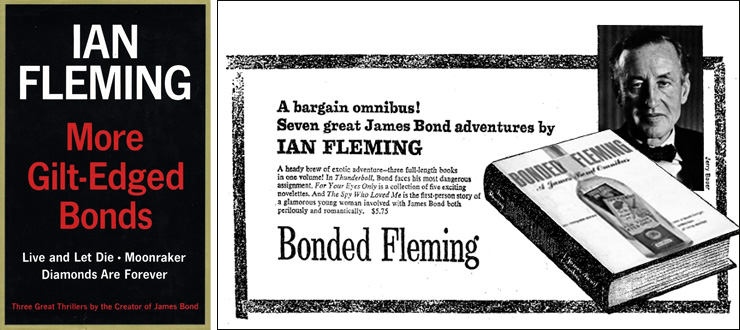 |
||||
|
Not to be outdone, the Viking Press then released Bonded Fleming in October 1965, containing the three titles for which they still held the US hardcover rights. Advertised as a bargain omnibus of seven great James Bond adventures, the collection of FOR YOUR EYES ONLY, THUNDERBALL and THE SPY WHO LOVED ME had a rather more attractive dust jacket designed by Al Cetta. The rear flap of the dust jacket had a brief biography of Ian Fleming and a photograph of the author by Jerry Bauer (1934-2010). This edition proved very popular and was reprinted a further four times over the next year. |
||||
 |
||||
|
Along with the two omnibus editions of Ian Fleming's James Bond novels, selected titles were also available in hardcover in August 1965 as part of the Book Club ‘Dollar Mystery Guild’ series, with a uniform cover style. The series was issued many times well into the 1970s, and alternate coloured dust jackets exist for all titles. The eight novels issued as Book Club editions in 1965 were CASINO ROYALE, MOONRAKER, FROM RUSSIA WITH LOVE, DOCTOR NO, GOLDFINGER, THUNDERBALL, THE SPY WHO LOVED ME and YOU ONLY LIVE TWICE, with THE MAN WITH THE GOLDEN GUN following in 1966. The rear of the dust jackets featured Dan Wynn's 1961 portrait of Ian Fleming (seen on the New American Library hardcover edition of ON HER MAJESTY'S SECRET SERVICE), and a brief biography of the author. |
||||
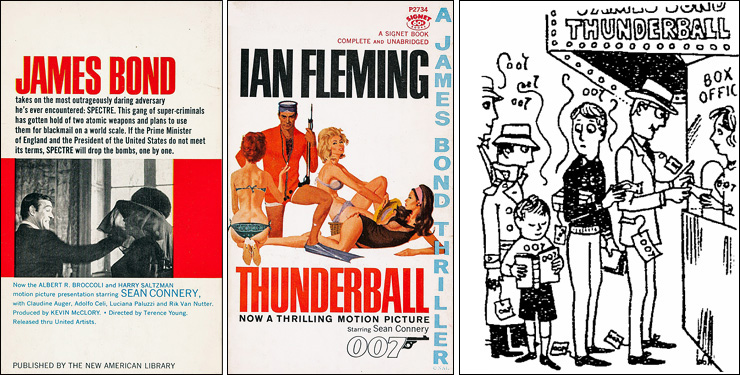 |
||||
|
A Signet movie tie-in edition of THUNDERBALL was issued in paperback shortly before the release of the fourth James Bond film starring Sean Connery in December 1965. Although actually premiered in Tokyo on December 9th, Thunderball would open in the United States a week before its UK double premiere at the London Pavilion and Rialto cinemas on December 29, 1965. At the height of ‘Bondmania’ in the mid-1960s Ian Fleming's novels had by now sold 32-million copies in the USA, and a staggering 20-million in the UK alone. With the release of Thunderball in December 1965, the world went James Bond crazy, and every conceivable kind of product was branded with a ‘007’ logo. For a short time Ian Fleming's incredible creation was the world's most profitable marketing icon. But the Bond boom had reached its zenith, and James Bond's creator was no longer around to enjoy the success. The man who had breathed life into his creation on the cinema screen was also beginning to tire of the character. There was one last gasp in 1966 with the release of OCTOPUSSY AND THE LIVING DAYLIGHTS, but sales and interest in the James Bond novels would never again achieve the heights of success they did in the wake of the release of Thunderball. With Sean Connery's announcement that You Only Live Twice would be his last James Bond film, and no new novels left to publish, it looked like the bubble had burst and James Bond in print at least, had reached the end of his life. |
||||
|
||||